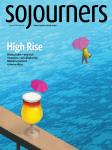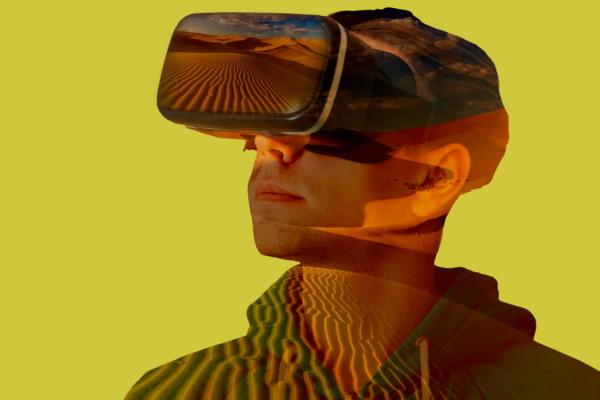PRE-EXPERIENCE: Welcome!
You’re alone except for a receptionist, who gently asks you to sign a waiver and gestures to the couch. The sand-colored cushions perfectly complement the soft pink glow of the wall and a pot of shellacked succulents. The coffee is pleasantly warm. The room temperature is perfect. Everything is fine.
You’re here for “Carne y Arena,” a virtual reality experience created by Mexican filmmaker Alejandro G. Iñárritu. The project recreates the experiences of immigrants who cross the Mexico-U.S. border. In 2017, “Carne y Arena” (“Flesh and Sand”) won a Special Award Oscar, the first given for virtual reality. The exhibit accommodates only one visitor at a time, at 15-minute intervals.
You wait on the couch, feeling a twinge of anxiety over an immersive experience that requires isolation and allows no cameras or notebooks. You contemplate the Pinterest-nirvana of the lobby and scratch a few notes while you can.
Entry: So where are we, exactly?
Soon, you’re escorted through the doors of the exhibit, which is housed in an old Baptist church in a gentrifying neighborhood in Washington, D.C. The project will take place across three rooms, a triptych of the migrant experience.
The church was slated for demolition before “Carne y Arena.” On the way in, you pass walls that look strangely familiar—you’ll later realize they are repurposed fence panels from the U.S.-Mexico border, turned horizontal to fit the dimensions of the house of God. You’re pretty sure that works as a metaphor, but before you can chew on it, you’re inside.
The Freezer: Give us your jacket
It’s cold. Freezing cold. A sign, in English and Spanish, instructs you to remove your shoes, put them in a locker, and sit on a cold metal bench until an alarm sounds. As you sit, you notice shoes spread across the concrete. Another sign explains that these shoes were left behind by immigrants in the Sonoran Desert. They’ve been collected over a period of seven years. Not a single shoe has a match.
At first, the silence is meditative. You take a few deep breaths, prepare for the alarm.
Nothing happens.
You look closer at the shoes: A little pink sandal. A dusty sneaker. Your temples tingle with shame, and you start to try to imagine the human foot that might have inhabited that shoe, but your brain abruptly switches gears, to a memory of another pile of shoes, at the Holocaust Museum just down the road. You were 12 years old when you saw those shoes, dread artifacts of a distant, incomprehensible evil. You’ve never shaken the image.
A voice splits the silence: “Put your jacket in the locker, thank you,” and the hairs on your neck stand straight up. How did they know you were wearing a jacket. You’ve underestimated Iñárritu. The tagline of the experience is “virtually present, physically invisible.” But you don’t feel invisible, in this sparse, hostile cell, you feel seen—devastatingly seen—and utterly inconsequential.
The experience has begun.
The Sonoran: There are no rules
If you’ve tried “virtual reality,” you know it’s not the dystopian adventureland it sounds like, not yet. It’s basically like watching a 360-degree video: everything we’re used to in cinema, except the action is not confined to a 2-D rectangle. This gives the viewer more agency, and the cinematographer more work: If I, the watcher, can run anywhere, then you, the director, have to make sure something interesting is happening everywhere.
It is immediately clear, as you walk into a hot, darkened room and feel desert sand crunch beneath your toes, that what Iñárritu has created breaks and elevates all of that. Monosyllabic attendants clad in head-to-toe black tell you that you will be left alone, strapped to a backpack, headphones covering your ears, goggles covering your eyes. You swallow, nodding, and put on the goggles. You’re in.
Blink.
The gorgeous, ominous desert is before you. A light wind blows, shaking both the cactus in the virtual Sonoran and the hairs on your real arm. You feel a light panic rise, fighting disorientation: Within seconds, all of your senses are working overtime to persuade your brain that you’re actually here.
Then: A low wailing, and a line of people appears, shuffling toward you. They are bowed over in the heat, some carrying children, others collapsing from dehydration. The coyote guide is on his phone, while an old man searches for shade. Parents and children come closer, nearly walking through you. They are so vulnerable out here, and so alone.
Out of nowhere a helicopter roars, and the ground shakes beneath you, sand swirling around your feet. Everyone panics. Searchlights, trucks pulling up, guns pointed, Border Patrol yelling in English and Spanish. Shit, you think, and your knees hit the ground, slamming the sand, a pathetic attempt to stay hidden. People around you are being dragged toward the trucks, and your brain is yelling DON’T HURT THEM (RELAX IT’S NOT REAL) STOP DOING THAT (BREATHE) (OH, JESUS) GET OUT GET ME OUT OF HERE.
You turn, frantic, and spot someone hiding in the bushes. As if he sees you, as if you’ve given something away, an agent sees the same person, yells, directs others to the hiding spot. No. You were supposed to be invisible, how did you rat someone out? No one said you’d watch families be separated, hauled away. No one said you’d have a gun pointed right at you. Are you going to be dragged into a truck? Oh God, is that man going to die, are you going to watch that man die, what is happ—
Blink.
The tableau rolls away, and the sun breaks over an empty desert, the dust from the night raid settling like a bad memory. You’ll read, later, that you could have seen shoes left behind, shoes that echo, chillingly, the ones you saw in the freezer. You don’t see them now, though. You’re alone in a pleasant sandscape, thinking you might vomit. You want to weep. You want to die.
“Thanks! Please step into the next room,” says an attendant, lifting your goggles and headphones. You go, the walls turning sideways around you.
The Gallery: Every name
The migrants have names and stories, of course. You meet them in this gallery, tamely lit and curtained. Faces look out at you from the wall, next to lines of text that tell stories of courage and bravery.
“Life has asked so much of me, and has given so little.” —Amaru, 20, El Salvador
“One day I prayed to God to be able to sit down at a table and eat with my own family.” —Manuel, 19, Guatemala
The comedown from the previous room is exhausting, and strangely alienating. You have just encountered adrenaline-spiking, life-threatening trauma. Now, just as immediately, you’re back to being invisible. Instead, you’re asked to look at Amaru, at Manuel.
Once again, Iñárritu has out-maneuvered his audience. What can you do with this harrowing experience, utterly devastating and yet not even real?
At the end of the gallery of stories is a notebook for visitors. Every entry is a variation on the same things: fear, heartbreak, urgency, a call for action. And gratitude.
Post-Experience: Flesh and sand
They say that what you do in “Carne y Arena” is a shibboleth for how you see the world. Your teammate, who went in before you, saw beating hearts inside each person; a boy removing his shoes; a mother holding a baby. He engaged with wonder, with grief. You saw none of this. You remember chopper blades, the end of a rifle. You felt every trauma you’ve ever experienced combine with every one of your worst fears. You were ready to fight, or hide, or bargain. You know, deeply, that you would have done anything to get away in one piece.
“This technology can be used very badly, scarily badly,” Iñárritu says. And for as profound and media-bending an entry into storytelling as “Carne y Arena” is, VR remains an expensive, elite tool, available to very few.
Iñárritu chooses to shatter the viewer, to break you open into something else, something that demands action, or heartbreak, or gratitude. It is empathy, but it’s a devastating dose.
A chilly rain splatters the windshield on your drive back to the office. You and your teammate are both silent for most of the ride. You put your arms around your legs. The Sonoran sand is still clinging to your knees.

Got something to say about what you're reading? We value your feedback!

